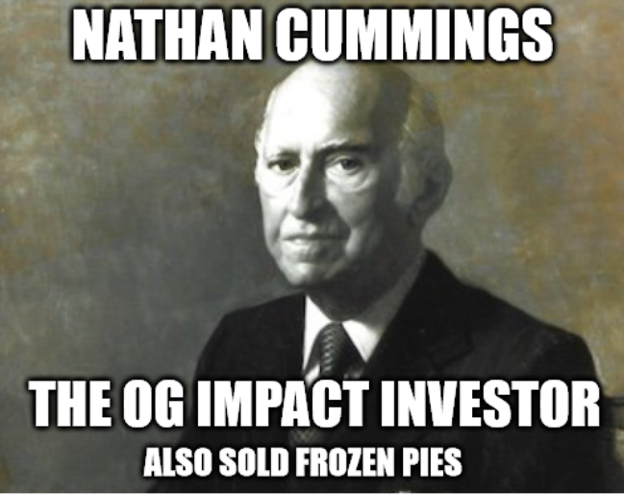The Guide to Crypto Impact Investing
Nathan Cummings was a grocery tycoon (you don’t hear those two words very often) who built Consolidated Foods, later known as The Sara Lee Corporation. The post The Guide to Crypto Impact Investing appeared first on Bitcoin Market Journal.


Nathan Cummings was a grocery tycoon (you don’t hear those two words very often) who built Consolidated Foods, later known as the Sara Lee Corporation. You may know Sara Lee for their frozen cakes, but the company was much more, selling a wide variety of foods, beverages, and household products around the world.
Nathan Cummings, born in Canada as the first child of Jewish Lithuanian immigrants, became a very rich man. As his wealth grew, he gave much of it away, becoming an avid philanthropist, especially in the arts. Later he established the Nathan Cummings Foundation, whose mission is “creating a more just, vibrant, sustainable, and democratic society.”
This is what we call “impact investing,” or investing in companies and causes that will
- a) make money, and
- b) have a measurable and beneficial social or environmental impact.
Both are important, so I’ll repeat it. The investment has to a) make money (otherwise it’s a charitable contribution), but the investment should also b) have a measurable benefit in “ESG”*:
- Environmental: The company must help the environment (or at least not actively harm it).
- Social: The company must treat workers fairly (or at least not actively violate human rights).
- Governance: Management and the board must be transparent and honest (or at least not sus).
The usual investing wisdom is that if you want to b) have a measurable and beneficial impact, then you a) won’t make as much money. This was the giant leap of faith that the Cummings Foundation took when it went from putting 5% to 100% of its wealth into impact investing.
Inspired by a New York Times article called A Family Opens Up About its Investing Mistakes (great headline), I read the Cummings Foundation Report on their “mistakes” in trying to transition their foundation from using 5% of their assets to using 100% of their assets to achieve their mission.
The story of how they made this transition is a page-scroller. While the foundation had made gradual steps toward responsible investing, the big showdown came at a board meeting in 2017, where several generations of Cummings family members had to win over independent trustees – and each other – to get a majority vote to take the leap of faith into 100% impact investing.

The drama is full of boardroom politics, family relationships, and risk-taking pioneers. They hired Lowell Weiss, the former editor of Atlantic Monthly and White House speechwriter, to write the story, which would make a great Netflix show (think Succession for the socially-conscious generation).
Perhaps most remarkably, the Cummings Foundation is practicing what they preach, opening up about what went well on their journey toward impact investing, and what they got wrong. In this guide, I’ll outline a few of the lessons they learned, and how we might apply these lessons to crypto investing.
Impact Investing: Three Big Takeaways
1) You can make just as much money with impact investing, and maybe more. “Our new investment approach has not required any financial sacrifice,” the foundation reports. “None.”
The foundation created extensive models to show their new impact investing strategy provided stronger returns, even in the topsy-turvy economy of 2020, than their traditional strategy. They explode the myth that impact investing is not a money-making proposition.
The reasons for this may be counterintuitive: it may be that cleaning up your mess, paying employees more fairly, and limiting executive compensation create stronger companies. They attract better people, which results in higher-quality goods and services and more innovation.
As a simple example, US automakers looked like reliable “blue chip stocks” for decades, until Tesla came along. Now they’re all playing catch up to Tesla’s stock price. The mission of “making really great electric cars” looked like a money-losing proposition, until Tesla showed you can make just as much money with clean cars, maybe a lot more.

2) Impact investing takes work. As the foundation shifted to 100% impact investing, they interviewed a ridiculous number of fund managers, discovering that most of them dabbled in this stuff on the side, to cater to a specific earthy-crunchy clientele. Few had impact investing in their DNA.
As they began to make decisions on how to reallocate the foundation’s considerable wealth, they had to pull out of a lot of investments, which was difficult and painful. (Imagine having those conversations.) Many of their investments would take years to wind down, drawing out the process even longer.
Then there was rigorous vetting and screening of all the potential investments they could make. What were the foundation’s core values? How would they evaluate investments across each of those values? (See their Appendix for their values, principles, and the specific questions they asked about potential investments.)
3) Impact investing needs better measurement metrics. How do we show whether companies are really delivering on our specific ESG goals? It’s easy for a company to say they’re committed to diversity and inclusion; how do we measure whether they practice what they preach?
The report points out that there are several competing frameworks for measuring the “impact” of impact investing, but no industry standard. However, they suggest we have to start somewhere.
Thus, starting to intentionally measure the impact of our investments – whether through the United Nations Sustainability Development Goals, the Impact Management Project, or your own Excel spreadsheet – is the first step. Start by measuring what you can.
These three lessons were hard-won, and I greatly appreciate the Cummings Foundation taking the time to share them. They’ve impacted my thinking on impact investing—specifically, in our new world of crypto investing.

“E”: The Environmental Impact of Crypto
Let’s be honest: bitcoin uses a lot of energy. The mining rigs that keep the bitcoin network humming consume a vast amount of electricity—about the same as all the rest of the data centers worldwide.
That’s right: bitcoin uses as much power – and creates as much planet-warming greenhouse gas – as all those servers that run our spreadsheets, Netflix, and YouTube, combined.
But holding bitcoin long-term – our preferred investing strategy – does not consume additional energy. And there are other ways we can shift our crypto investments to favor what’s better for the environment.
- We can invest in mining farms run on renewable energy. In this report, George Kaloudis discusses bitcoin’s rapid movement to clean energy: about 40% of bitcoin mining is powered by clean energy, versus 20% for overall energy consumption worldwide. Kaloudis makes the case that bitcoin could accelerate the global transition to renewable energy. A Cornell study shows that renewable energy projects like wind or solar farms could recoup millions of dollars in mining bitcoin, which developers could re-invest into more renewable energy projects.If we end up with more solar farms and wind turbines because bitcoin miners (driven by investors) are demanding them, that’s a terrific outcome for the planet.
- We can invest in blockchain platforms run on Proof of Stake. It’s like the difference between solar and coal: Proof of Stake is not just marginally more efficient than Proof of Work, it’s a totally different ballgame. Some PoS blockchain networks like Algorand (ALGO) are even pledging to be carbon negative: to give back more to the environment than they take out. (See our list of Top PoS Investments.)
- We can HODL instead of trading. Whenever you buy or sell bitcoin, it creates another entry in the shared digital ledger, which has a “domino effect” of getting replicated across every bitcoin node worldwide. If you’re constantly trying to buy low and sell high, it’s not only bad investing strategy – no one can time the market over the long term – it’s also bad for the planet. HODL and keep the planet CODL.
Environmental Crypto Investing Ideas:
- SolarCoin (SLR) rewards producers with tokens for generating solar power.
- Energy Web Token (EWT) tracks and certifies renewable energy production.
- Powerledger (POWR) lets users buy and sell locally-produced solar or wind energy, peer-to-peer.

When we HODL, we keep the planet CODL.
“S”: The Social Impact of Crypto
A core argument about crypto is that it helps to “bank the unbanked.”
Is it?
Last time I looked, those without access to the traditional financial system – which includes banking, lines of credit, mortgages, and so on – were not exactly investing in crypto. How would they? You still need to deposit the funds from somewhere, usually a bank.
We talk about redistributing wealth, but what I see is that crypto wealth is just getting redistributed to the whales who already have most of the crypto wealth. Even in crypto, the rich get richer.
We talk about building a new system of “financial inclusion,” but crypto is still so hard to use – especially out on the fringes of Web3– that I can’t imagine that more than 1% of the world can figure it out.
No doubt we are making crypto more user-friendly, but most people still don’t have the time, technology, or talent to get into it. If you’re a single parent working minimum wage, living paycheck to paycheck, buying bitcoin is hardly your way out.
Also, “crypto investing” is still an oxymoron. For most people, it’s more like “crypto gambling.” There’s a get-rich-quick mentality that leads to increasingly risky derivatives and crazy speculative bubbles.
Crypto investors don’t want to “bank the unbanked.” They want to “make bank.”
What can we do to change this story? We can:
1) Invest in blockchain projects with low fees (preferably no fees). Anyone who talks about how crypto will help the unbanked with lower fees just hasn’t used crypto recently. When it costs $12 to make a $3 ETH transfer, we can legitimately ask what the hell is happening. Fees are the dirty secret of this industry, an insidious problem that needs the best and brightest minds to solve. The best fee is zero.
2) Invest in blockchain projects that are solving real social problems. Binance Charity Foundation, which we cover in our book, is a nonprofit that allows investors to donate in crypto – which goes directly to recipients worldwide. This has a direct and tangible benefit of getting the unbanked to open crypto wallets in order to receive the money, as well as total transparency of where your donation is going, as it’s all recorded on the blockchain.
3) Avoid investing in meme stocks like $GME and meme coins like DOGE. These cater to unsophisticated investors who want to get rich quick, and prey on their ignorance by disguising it as “fun” to lose money.
Social Crypto Investing Ideas:
- Basic Attention Token (BAT) is used on the Brave browser to reward users for their attention, creating a better advertising system that respects user privacy.
- Celo (CELO) is a blockchain platform focused on increasing financial inclusion through mobile phones.
- Binance Charity Foundation (mentioned above) allows you to donate your crypto to great causes around the world.

“G”: The Governance of Crypto
Today the crypto industry is mostly white and male. That leads to a lot of testosterone-fueled, risk-taking behavior—which is bad for investors, and bad for the industry.
Fortunately, there are many women getting involved in blockchain through groups like Global Women in Blockchain, but (in my experience) it is rare to see woman-led blockchain startups. It is rarer still to see blockchain projects led by people of color.
I serve on the board of the Boston Blockchain Association, and it’s a problem we’ve been working on for the last few years. We’ve been intentional about bringing women onto our board, with one board member focused on diversity. Diversity can be done, but it must be intentional.
As investors, we can:
1) Look for women- and minority-led blockchain projects. Obviously, we want to find projects with real value, but we must overcome unconscious biases that the most valuable projects will come from young white dudes.
2) Avoid projects without clearly identifiable founders. We continue to see new projects launched by anonymous founders, which does not bode well for governance down the road. If there’s no accountability at launch, there won’t be accountability later on.
3) For community-governed projects, get involved with the process. Most new crypto companies allow token holders to have a say in governance. If people don’t get involved, these projects can get biased toward the largest token holders. If you own a token, try to be involved (or at least aware) of what’s happening behind the scenes. Get involved with governance.
Governance Crypto Investing Ideas:
- Polkadot (DOT) emphasizes on-chain governance, giving token holders a direct say in the direction and development of the platform.
- Cardano (ADA) allocates a portion of each transaction fee to a treasury fund, which is used to finance future development, with projects voted on by ADA holders.
- Any crypto project with governance voting. Once you invest in the token, you’re eligible to vote!
The Biggest Impact is the Idea
Perhaps the most enduring contribution the Cummings Foundation has made to impact investing is the report itself. It’s not just the power of example, but being willing to open up about their example. Even if the journey wasn’t easy, it’s an easy read. That helps.
They’re trying to change the momentum of the entire investing economy. Our job is much easier, because the crypto industry is so much younger and smaller. It’s important that we begin to infuse these ideas into the industry now, to make them part of our crypto DNA.
We can’t just pay lip service to these ideals, we have to actually do something. The ideas above are a starting point, because we have to start somewhere. I hope you’ll join me in helping me put these ideas into action.
Together, we can inject these ideals into the blockchain bloodstream. Over time, this is how our investing can have world-changing impact.
* Note I have oversimplified concepts like ESG, SRI, and impact investing (see a more detailed description here). The lack of clear and consistent definitions between these is one of the issues highlighted in the Cummings Foundation Report.
The post The Guide to Crypto Impact Investing appeared first on Bitcoin Market Journal.







